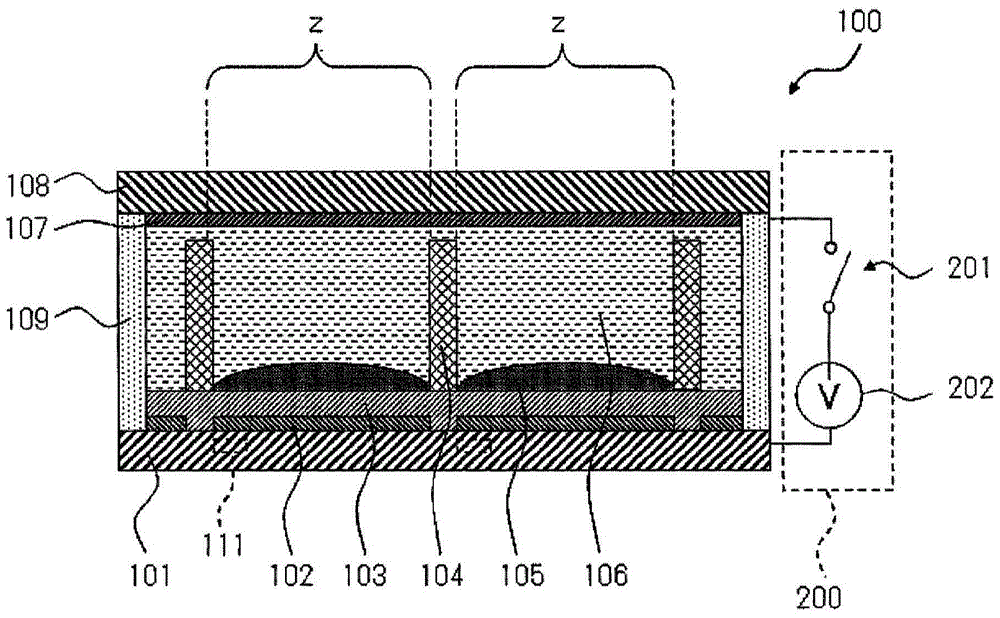High dielectric film
A dielectric and electrode technology, applied in the field of high dielectric films, can solve the problems of low driving voltage, easy generation of pinholes, low relative dielectric constant, etc., and achieve the effect of low dielectric loss and high relative dielectric constant.
- Summary
- Abstract
- Description
- Claims
- Application Information
AI Technical Summary
Problems solved by technology
Method used
Image
Examples
Synthetic example 1
[0308] Synthesis example 1 (production of VdF / TFE copolymer (a1))
[0309] 1.3 kg of pure water was charged into an autoclave with an inner volume of 4 L, and after nitrogen substitution was sufficiently performed, 1.3 g of octafluorocyclobutane was charged, and the temperature in the system was maintained at 37° C. at a stirring speed of 580 rpm. Thereafter, 200 g of a mixed gas of tetrafluoroethylene (TFE) / 1,1-difluoroethylene (vinylidene fluoride, VdF) = 7 / 93 mol %, 1 g of ethyl acetate, and then di-n-propylene peroxydicarbonate were added. 1 g of a 50% by mass methanol solution of the ester was used to initiate polymerization. Since the pressure in the system decreased as the polymerization proceeded, a mixed gas of tetrafluoroethylene / 1,1-difluoroethylene=7 / 93 mol % was continuously supplied to maintain the pressure in the system at 1.3 MPaG. Stirring was continued for 20 hours. Next, the pressure was released, and after returning to atmospheric pressure, the reaction p...
Synthetic example 2
[0310] Synthesis example 2 (production of VdF / TFE copolymer (a2))
[0311] 1.3 kg of pure water was charged into an autoclave with an inner volume of 4 L, and after nitrogen substitution was sufficiently performed, 1.3 g of octafluorocyclobutane was charged, and the inside of the system was kept at 37° C. at a stirring speed of 580 rpm. Thereafter, 200 g of a mixed gas of tetrafluoroethylene (TFE) / 1,1-difluoroethylene (vinylidene fluoride, VdF) = 20 / 80 mol %, 1 g of ethyl acetate, and then di-n-propylene peroxydicarbonate were added. 1 g of a 50% by mass methanol solution of the ester was used to initiate polymerization. Since the pressure in the system decreased as the polymerization proceeded, a mixed gas of tetrafluoroethylene / 1,1-difluoroethylene=20 / 80 mol % was continuously supplied to maintain the pressure in the system at 1.3 MPaG. Stirring was continued for 20 hours. Next, the pressure was released, and after returning to atmospheric pressure, the reaction product was ...
Synthetic example 3
[0312] Synthesis example 3 (production of VdF / TFE copolymer (a3))
[0313] 1.3 kg of pure water was put into an autoclave with a phase inner volume of 4 L, and after nitrogen replacement was fully carried out, 1.3 g of octafluorocyclobutane was put in, and the temperature in the system was maintained at 37° C. and the stirring speed was 580 rpm. Thereafter, 200 g of a mixed gas of tetrafluoroethylene (TFE) / 1,1-difluoroethylene (vinylidene fluoride, VdF) = 18 / 82 mol %, 1 g of ethyl acetate, and then di-n-propyl peroxydicarbonate were added. 1 g of a 50% by mass methanol solution of the ester was used to initiate polymerization. Since the pressure in the system decreased as the polymerization proceeded, a mixed gas of tetrafluoroethylene / 1,1-difluoroethylene=18 / 82 mol % was continuously supplied to maintain the pressure in the system at 1.3 MPaG. Stirring was continued for 20 hours. Next, the pressure was released, and after returning to atmospheric pressure, the reaction prod...
PUM
| Property | Measurement | Unit |
|---|---|---|
| particle size | aaaaa | aaaaa |
| melting point | aaaaa | aaaaa |
| thickness | aaaaa | aaaaa |
Abstract
Description
Claims
Application Information
 Login to View More
Login to View More - R&D
- Intellectual Property
- Life Sciences
- Materials
- Tech Scout
- Unparalleled Data Quality
- Higher Quality Content
- 60% Fewer Hallucinations
Browse by: Latest US Patents, China's latest patents, Technical Efficacy Thesaurus, Application Domain, Technology Topic, Popular Technical Reports.
© 2025 PatSnap. All rights reserved.Legal|Privacy policy|Modern Slavery Act Transparency Statement|Sitemap|About US| Contact US: help@patsnap.com



